Abstract
The percentages of peripheral blood lymphocytes (PBL), bearing Fc receptors for IgE (Fc epsilon R) and IgG (Fc gamma R) were determined in four patients with the hyper IgE syndrome by a rosette assay employing IgE and IgG coated fixed ox erythrocytes. The patients had 8 +/- 3% Fc epsilon R+ and 13 +/- 8% Fc gamma R+ PBL, compared to 1.2 +/- 1% Fc epsilon R+ and 17 +/- 4% Fc gamma R+ PBL for control donors. T cells were isolated by rosetting with neuraminidase treated sheep erythrocytes (EN). Indirect immunofluorescence with Lyt 3 monoclonal antibody (MoAb) to the sheep erythrocyte receptor, followed by rosetting for Fc epsilon R and Fc gamma R showed that the patients' T cells contained less than 0.1% Fc epsilon R+ and 1.4 +/- 0.2% Fc gamma R+ cells; T cells from the control subjects contained less than 0.1% Fc epsilon R+ and 11 +/- 4% Fc gamma R+ cells. The non-T (EN rosette depleted) cells of the patients included 56 +/- 18% sIgM+/sIgD+, 45 +/- 9% Fc epsilon R+ and 35 +/- 27% Fc gamma R+ cells. Indirect immunofluorescence with MoAb to IgM, IgD, and NK cells (antibody B73.1) followed by rosetting for Fc epsilon R and Fc gamma R, indicated that 92 +/- 2% of the Fc epsilon R+ cells and 9 +/- 7% of the Fc gamma R+ cells were B cells (mu+/delta+), while 3 +/- 4% of the Fc epsilon R+ and 30 +/- 23% of the Fc gamma R+ cells were NK cells (B73.1+). Thus, most of the Fc epsilon R+ non-T cells were B cells, and only a small fraction appeared to be NK cells. On the other hand, Fc gamma R+ B cells were outnumbered by Fc gamma R+ NK cells (B73.1+) by three to one. The data indicate that patients with the hyper IgE syndrome have increased numbers of Fc gamma R+ PBL, most of them being B cells, whereas their T cells contain less than 0.1% Fc epsilon R+ cells.
Full text
PDF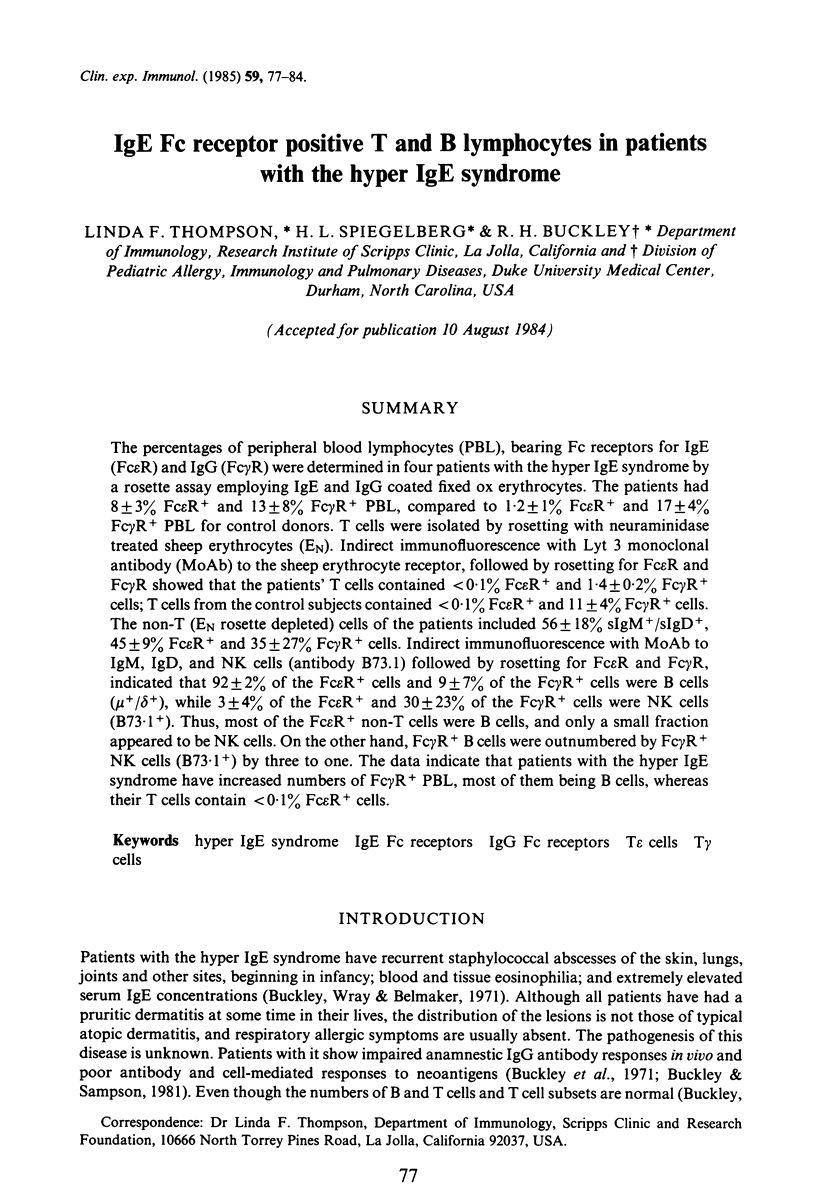
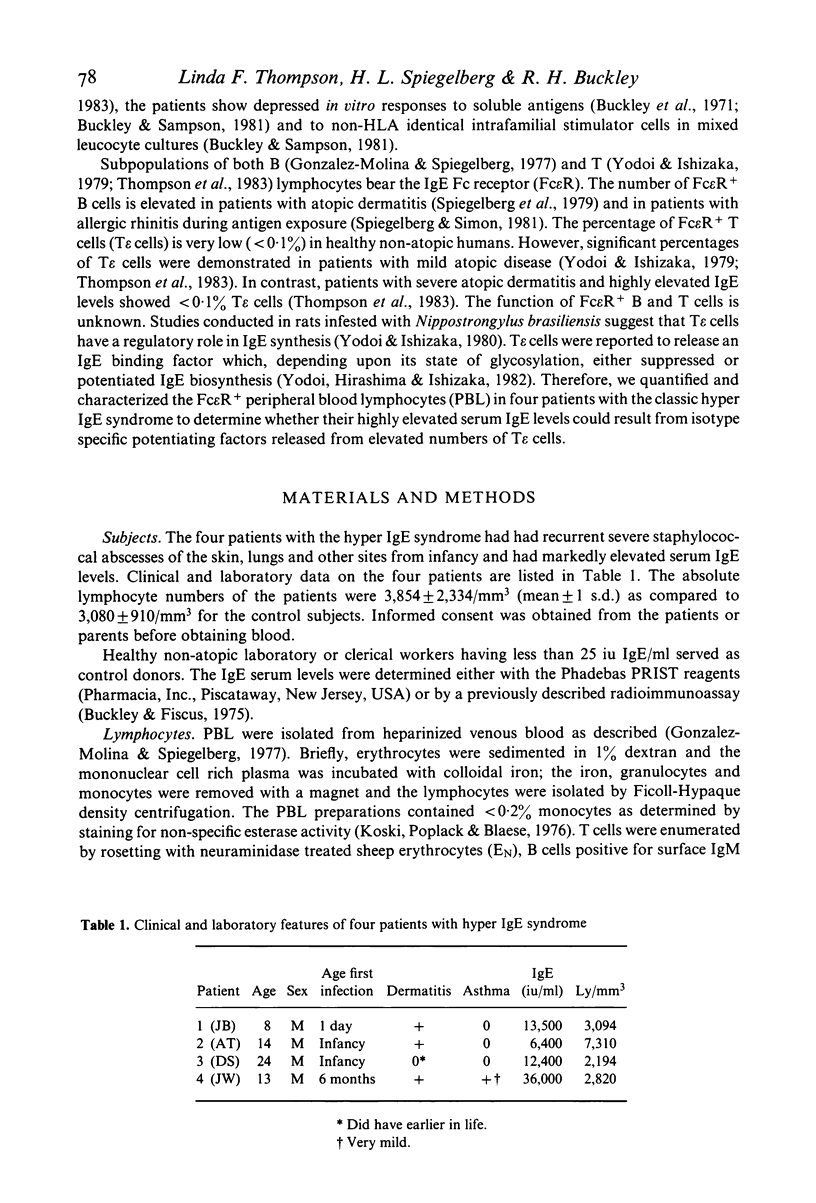
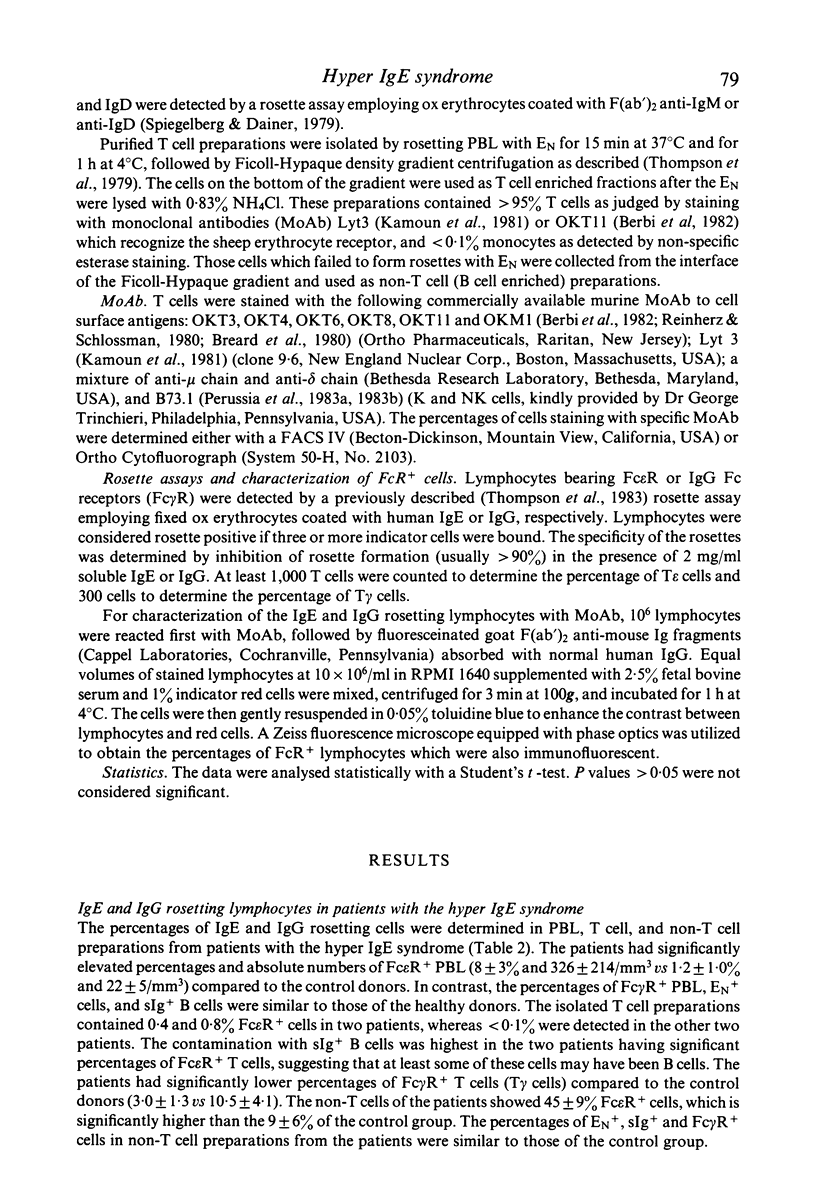
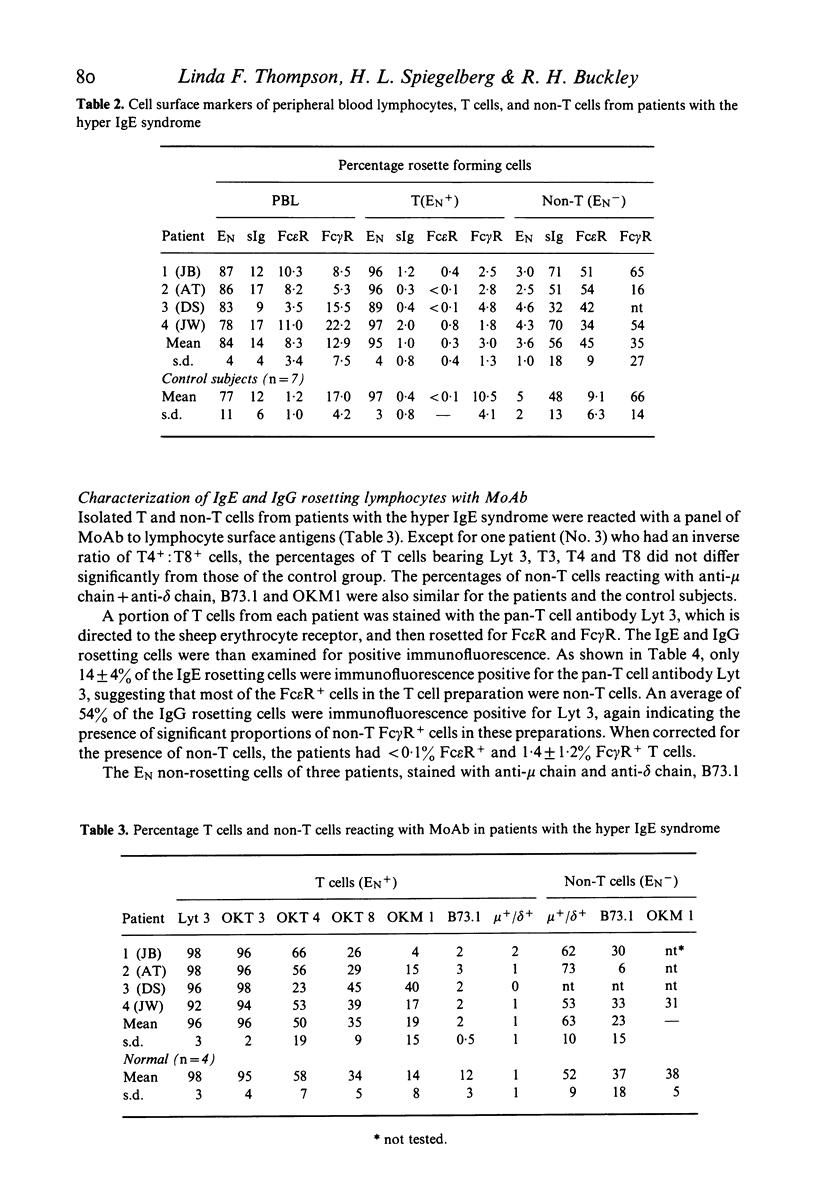
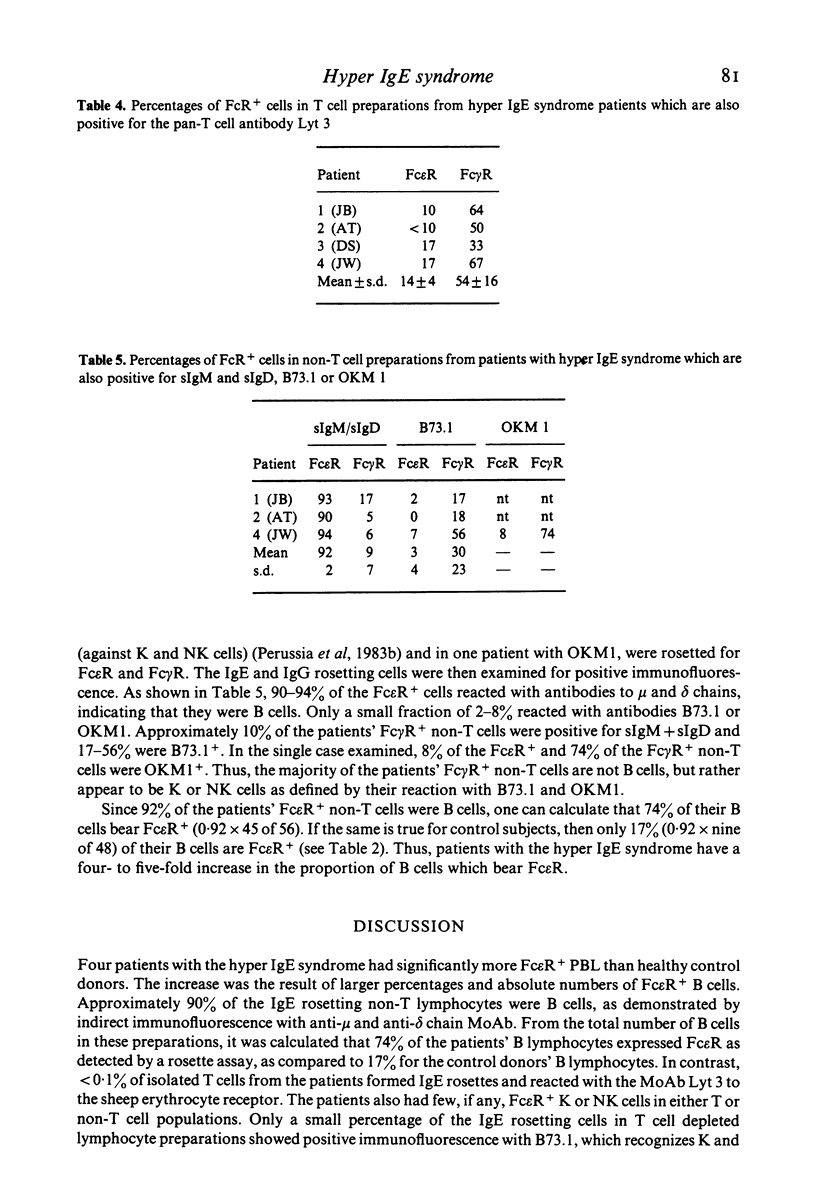
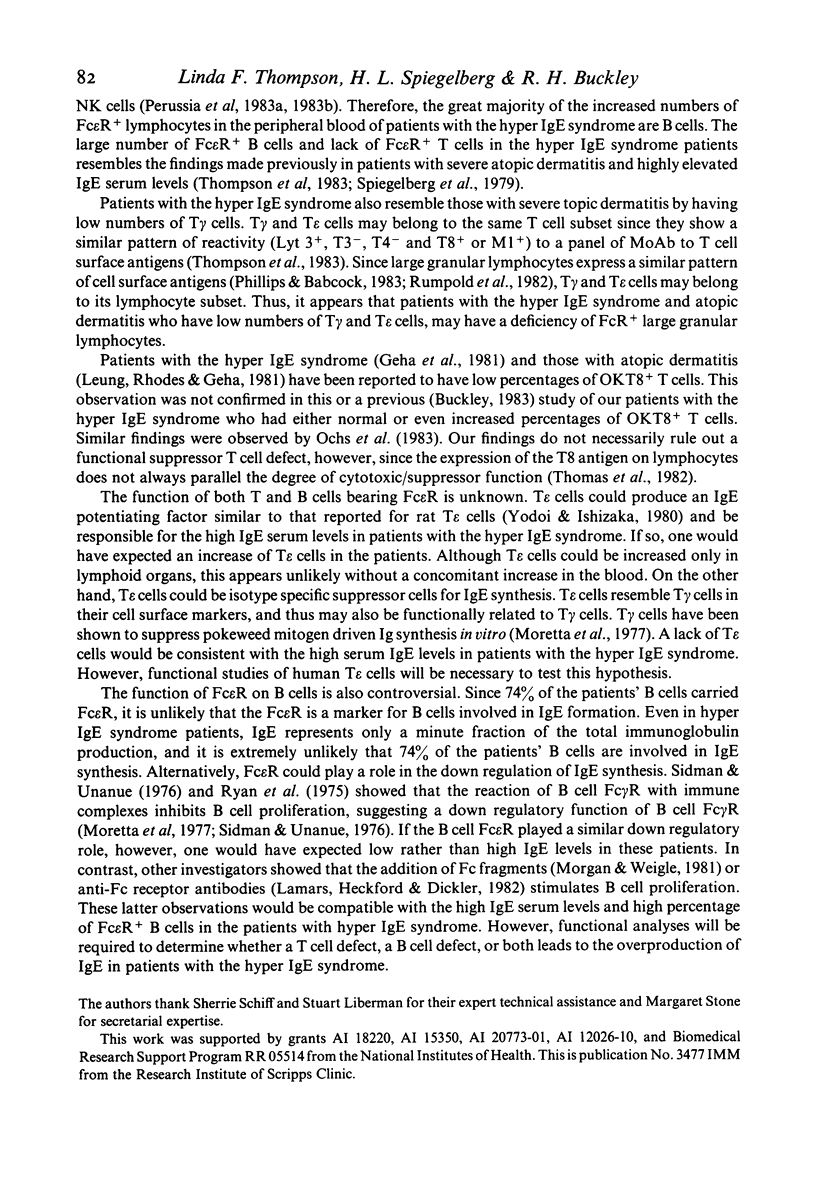
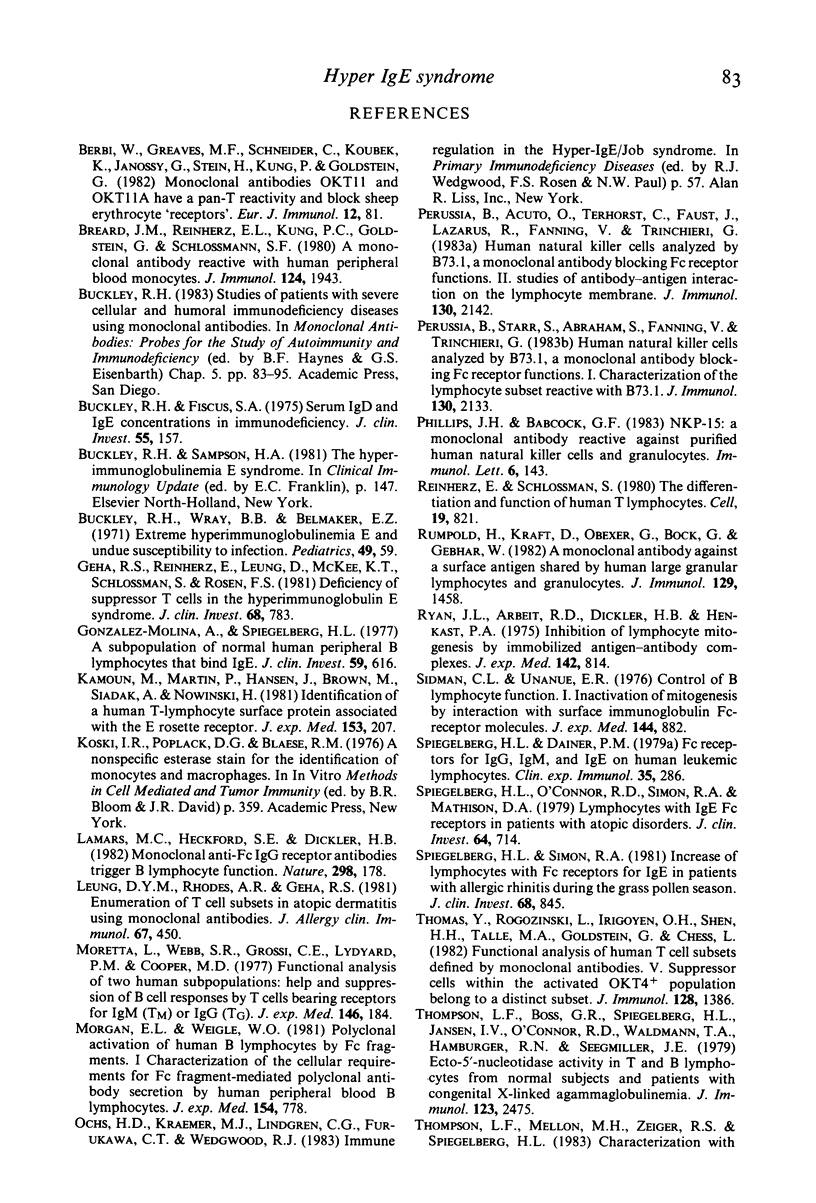

Selected References
These references are in PubMed. This may not be the complete list of references from this article.
- Breard J., Reinherz E. L., Kung P. C., Goldstein G., Schlossman S. F. A monoclonal antibody reactive with human peripheral blood monocytes. J Immunol. 1980 Apr;124(4):1943–1948. [PubMed] [Google Scholar]
- Buckley R. H., Fiscus S. A. Serum IgD and IgE concentrations in immunodeficiency diseases. J Clin Invest. 1975 Jan;55(1):157–165. doi: 10.1172/JCI107906. [DOI] [PMC free article] [PubMed] [Google Scholar]
- Buckley R. H., Wray B. B., Belmaker E. Z. Extreme hyperimmunoglobulinemia E and undue susceptibility to infection. Pediatrics. 1972 Jan;49(1):59–70. [PubMed] [Google Scholar]
- Geha R. S., Reinherz E., Leung D., McKee K. T., Jr, Schlossman S., Rosen F. S. Deficiency of suppressor T cells in the hyperimmunoglobulin E syndrome. J Clin Invest. 1981 Sep;68(3):783–791. doi: 10.1172/JCI110315. [DOI] [PMC free article] [PubMed] [Google Scholar]
- Gonzalez-Molina A., Spiegelberg H. L. A subpopulation of normal human peripheral B lymphcytes that bind IgE. J Clin Invest. 1977 Apr;59(4):616–624. doi: 10.1172/JCI108679. [DOI] [PMC free article] [PubMed] [Google Scholar]
- Kamoun M., Martin P. J., Hansen J. A., Brown M. A., Siadak A. W., Nowinski R. C. Identification of a human T lymphocyte surface protein associated with the E-rosette receptor. J Exp Med. 1981 Jan 1;153(1):207–212. doi: 10.1084/jem.153.1.207. [DOI] [PMC free article] [PubMed] [Google Scholar]
- Lamers M. C., Heckford S. E., Dickler H. B. Monoclonal anti-Fc IgG receptor antibodies trigger B lymphocyte function. Nature. 1982 Jul 8;298(5870):178–180. doi: 10.1038/298178a0. [DOI] [PubMed] [Google Scholar]
- Leung D. Y., Rhodes A. R., Geha R. S. Enumeration of T cell subsets in atopic dermatitis using monoclonal antibodies. J Allergy Clin Immunol. 1981 Jun;67(6):450–455. doi: 10.1016/0091-6749(81)90098-1. [DOI] [PubMed] [Google Scholar]
- Moretta L., Webb S. R., Grossi C. E., Lydyard P. M., Cooper M. D. Functional analysis of two human T-cell subpopulations: help and suppression of B-cell responses by T cells bearing receptors for IgM or IgG. J Exp Med. 1977 Jul 1;146(1):184–200. doi: 10.1084/jem.146.1.184. [DOI] [PMC free article] [PubMed] [Google Scholar]
- Morgan E. L., Weigle W. O. Polyclonal activation of human B lymphocytes by Fc fragments. I. Characterization of the cellular requirements for Fc fragment-mediated polyclonal antibody secretion by human peripheral blood B lymphocytes. J Exp Med. 1981 Sep 1;154(3):778–790. doi: 10.1084/jem.154.3.778. [DOI] [PMC free article] [PubMed] [Google Scholar]
- Perussia B., Acuto O., Terhorst C., Faust J., Lazarus R., Fanning V., Trinchieri G. Human natural killer cells analyzed by B73.1, a monoclonal antibody blocking Fc receptor functions. II. Studies of B73.1 antibody-antigen interaction on the lymphocyte membrane. J Immunol. 1983 May;130(5):2142–2148. [PubMed] [Google Scholar]
- Perussia B., Starr S., Abraham S., Fanning V., Trinchieri G. Human natural killer cells analyzed by B73.1, a monoclonal antibody blocking Fc receptor functions. I. Characterization of the lymphocyte subset reactive with B73.1. J Immunol. 1983 May;130(5):2133–2141. [PubMed] [Google Scholar]
- Phillips J. H., Babcock G. F. NKP-15: a monoclonal antibody reactive against purified human natural killer cells and granulocytes. Immunol Lett. 1983 Mar;6(3):143–149. doi: 10.1016/0165-2478(83)90096-2. [DOI] [PubMed] [Google Scholar]
- Reinherz E. L., Schlossman S. F. The differentiation and function of human T lymphocytes. Cell. 1980 Apr;19(4):821–827. doi: 10.1016/0092-8674(80)90072-0. [DOI] [PubMed] [Google Scholar]
- Rumpold H., Kraft D., Obexer G., Böck G., Gebhart W. A monoclonal antibody against a surface antigen shared by human large granular lymphocytes and granulocytes. J Immunol. 1982 Oct;129(4):1458–1464. [PubMed] [Google Scholar]
- Ryan J. L., Arbeit R. D., Dickler H. B., Henkart P. A. Inhibition of lymphocyte mitogenesis by immobilized antigen-antibody complexes. J Exp Med. 1975 Oct 1;142(4):814–826. doi: 10.1084/jem.142.4.814. [DOI] [PMC free article] [PubMed] [Google Scholar]
- Sidman C. L., Unanue E. R. Control of B-lymphocyte function. I. Inactivation of mitogenesis by interactions with surface immunoglobulin and Fc-receptor molecules. J Exp Med. 1976 Oct 1;144(4):882–896. doi: 10.1084/jem.144.4.882. [DOI] [PMC free article] [PubMed] [Google Scholar]
- Spiegelberg H. L., Dainer P. M. Fc receptors for IgG, IgM and IgE on human leukaemic lymphocytes. Clin Exp Immunol. 1979 Feb;35(2):286–295. [PMC free article] [PubMed] [Google Scholar]
- Spiegelberg H. L., O'Connor R. D., Simon R. A., Mathison D. A. Lymphocytes with immunoglobulin E Fc receptors in patients with atopic disorders. J Clin Invest. 1979 Sep;64(3):714–720. doi: 10.1172/JCI109514. [DOI] [PMC free article] [PubMed] [Google Scholar]
- Spiegelberg H. L., Simon R. A. Increase of lymphocytes with Fc receptors for IgE in patients with allergic rhinitis during the grass pollen season. J Clin Invest. 1981 Oct;68(4):845–852. doi: 10.1172/JCI110339. [DOI] [PMC free article] [PubMed] [Google Scholar]
- Thomas Y., Rogozinski L., Irigoyen O. H., Shen H. H., Talle M. A., Goldstein G., Chess L. Functional analysis of human T cell subsets defined by monoclonal antibodies. V. Suppressor cells within the activated OKT4+ population belong to a distinct subset. J Immunol. 1982 Mar;128(3):1386–1390. [PubMed] [Google Scholar]
- Thompson L. F., Boss G. R., Spiegelberg H. L., Jansen I. V., O'Connor R. D., Waldmann T. A., Hamburger R. N., Seegmiller J. E. Ecto-5'-nucleotidase activity in T and B lymphocytes from normal subjects and patients with congenital X-linked agammaglobulinemia. J Immunol. 1979 Dec;123(6):2475–2478. [PubMed] [Google Scholar]
- Thompson L. F., Mellon M. H., Zeiger R. S., Spiegelberg H. L. Characterization with monoclonal antibodies of T lymphocytes bearing Fc receptors for IgE (T epsilon cells) and IgG (T gamma cells) in atopic patients. J Immunol. 1983 Dec;131(6):2772–2776. [PubMed] [Google Scholar]
- Verbi W., Greaves M. F., Schneider C., Koubek K., Janossy G., Stein H., Kung P., Goldstein G. Monoclonal antibodies OKT 11 and OKT 11A have pan-T reactivity and block sheep erythrocyte "receptors". Eur J Immunol. 1982 Jan;12(1):81–86. doi: 10.1002/eji.1830120115. [DOI] [PubMed] [Google Scholar]
- Yodoi J., Hirashima M., Ishizaka K. Regulatory role of IgE-binding factors from rat T lymphocytes. V. The carbohydrate moieties in IgE-potentiating factors and IgE-suppressive factors. J Immunol. 1982 Jan;128(1):289–295. [PubMed] [Google Scholar]
- Yodoi J., Ishizaka K. Lymphocytes bearing Fc receptors for IgE. I. Presence of human and rat T lymphocytes with Fc epsilon receptors. J Immunol. 1979 Jun;122(6):2577–2583. [PubMed] [Google Scholar]
- Yodoi J., Ishizaka K. Lymphocytes bearing Fc receptors for IgE. IV. Formation of IgE-binding factor by rat T lymphocytes. J Immunol. 1980 Mar;124(3):1322–1329. [PubMed] [Google Scholar]


